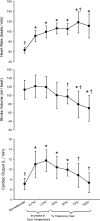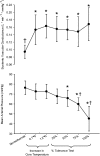Effect of heat stress on cardiac output and systemic vascular conductance during simulated hemorrhage to presyncope in young men
- PMID: 22367508
- PMCID: PMC3330796
- DOI: 10.1152/ajpheart.00941.2011
Effect of heat stress on cardiac output and systemic vascular conductance during simulated hemorrhage to presyncope in young men
Abstract
During moderate actual or simulated hemorrhage, as cardiac output decreases, reductions in systemic vascular conductance (SVC) maintain mean arterial pressure (MAP). Heat stress, however, compromises the control of MAP during simulated hemorrhage, and it remains unknown whether this response is due to a persistently high SVC and/or a low cardiac output. This study tested the hypothesis that an inadequate decrease in SVC is the primary contributing mechanism by which heat stress compromises blood pressure control during simulated hemorrhage. Simulated hemorrhage was imposed via lower body negative pressure (LBNP) to presyncope in 11 passively heat-stressed subjects (increase core temperature: 1.2 ± 0.2°C; means ± SD). Cardiac output was measured via thermodilution, and SVC was calculated while subjects were normothermic, heat stressed, and throughout subsequent LBNP. MAP was not changed by heat stress but was reduced to 45 ± 12 mmHg at the termination of LBNP. Heat stress increased cardiac output from 7.1 ± 1.1 to 11.7 ± 2.2 l/min (P < 0.001) and increased SVC from 0.094 ± 0.018 to 0.163 ± 0.032 l·min(-1)·mmHg(-1) (P < 0.001). Although cardiac output at the onset of syncopal symptoms was 37 ± 16% lower relative to pre-LBNP, presyncope cardiac output (7.3 ± 2.0 l/min) was not different than normothermic values (P = 0.46). SVC did not change throughout LBNP (P > 0.05) and at presyncope was 0.168 ± 0.044 l·min(-1)·mmHg(-1). These data indicate that in humans a cardiac output adequate to maintain MAP while normothermic is no longer adequate during a heat-stressed-simulated hemorrhage. The absence of a decrease in SVC at a time of profound reductions in MAP suggests that inadequate control of vascular conductance is a primary mechanism compromising blood pressure control during these conditions.
Figures


Similar articles
-
Modelflow underestimates cardiac output in heat-stressed individuals.Am J Physiol Regul Integr Comp Physiol. 2011 Feb;300(2):R486-91. doi: 10.1152/ajpregu.00505.2010. Epub 2010 Nov 17. Am J Physiol Regul Integr Comp Physiol. 2011. PMID: 21084673 Free PMC article. Clinical Trial.
-
Small reductions in skin temperature after onset of a simulated hemorrhagic challenge improve tolerance in exercise heat-stressed individuals.Am J Physiol Regul Integr Comp Physiol. 2018 Sep 1;315(3):R539-R546. doi: 10.1152/ajpregu.00182.2018. Epub 2018 Aug 8. Am J Physiol Regul Integr Comp Physiol. 2018. PMID: 30088981
-
Insufficient cutaneous vasoconstriction leading up to and during syncopal symptoms in the heat stressed human.Am J Physiol Heart Circ Physiol. 2010 Oct;299(4):H1168-73. doi: 10.1152/ajpheart.00290.2010. Epub 2010 Aug 6. Am J Physiol Heart Circ Physiol. 2010. PMID: 20693394 Free PMC article.
-
The reciprocal relationship between cardiac baroreceptor sensitivity and cerebral autoregulation during simulated hemorrhage in humans.Auton Neurosci. 2022 Sep;241:103007. doi: 10.1016/j.autneu.2022.103007. Epub 2022 Jun 11. Auton Neurosci. 2022. PMID: 35716525 Free PMC article. Review.
-
Heat stress and baroreflex regulation of blood pressure.Med Sci Sports Exerc. 2008 Dec;40(12):2063-70. doi: 10.1249/MSS.0b013e318180bc98. Med Sci Sports Exerc. 2008. PMID: 18981943 Free PMC article. Review.
Cited by
-
Impact of environmental stressors on tolerance to hemorrhage in humans.Am J Physiol Regul Integr Comp Physiol. 2019 Feb 1;316(2):R88-R100. doi: 10.1152/ajpregu.00235.2018. Epub 2018 Dec 5. Am J Physiol Regul Integr Comp Physiol. 2019. PMID: 30517019 Free PMC article.
-
Phenylephrine increases near-infrared spectroscopy determined muscle oxygenation in men.J Clin Monit Comput. 2017 Dec;31(6):1159-1166. doi: 10.1007/s10877-016-9965-y. Epub 2016 Dec 16. J Clin Monit Comput. 2017. PMID: 27987104
-
Instrument to detect syncope and the onset of shock.Proc SPIE Int Soc Opt Eng. 2016 Feb;9708:970706. doi: 10.1117/12.2212803. Epub 2016 Mar 17. Proc SPIE Int Soc Opt Eng. 2016. PMID: 29056812 Free PMC article.
-
Heat stress attenuates the increase in arterial blood pressure during isometric handgrip exercise.Eur J Appl Physiol. 2013 Jan;113(1):183-90. doi: 10.1007/s00421-012-2428-3. Epub 2012 May 29. Eur J Appl Physiol. 2013. PMID: 22644569
-
Impairments in central cardiovascular function contribute to attenuated reflex vasodilation in aged skin.J Appl Physiol (1985). 2015 Dec 15;119(12):1411-20. doi: 10.1152/japplphysiol.00729.2015. Epub 2015 Oct 22. J Appl Physiol (1985). 2015. PMID: 26494450 Free PMC article. Clinical Trial.
References
-
- Cooke WH, Ryan KL, Convertino VA. Lower body negative pressure as a model to study progression to acute hemorrhagic shock in humans. J Appl Physiol 96: 1249–1261, 2004 - PubMed
MeSH terms
Substances
LinkOut - more resources
Full Text Sources
Medical
Miscellaneous

